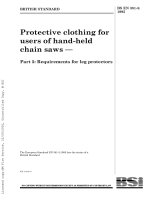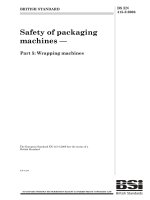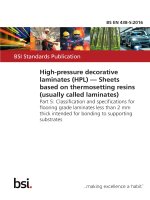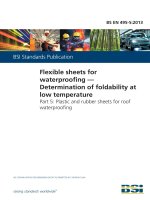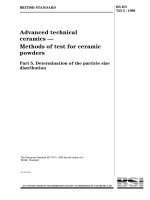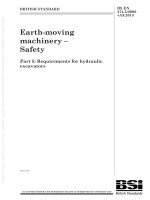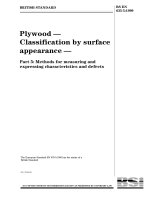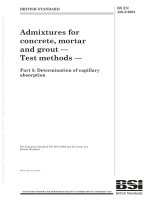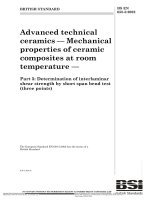Bsi bs en 61158 5 11 2008
Bạn đang xem bản rút gọn của tài liệu. Xem và tải ngay bản đầy đủ của tài liệu tại đây (576.22 KB, 90 trang )
BS EN 61158-5-11:2008
BSI British Standards
Industrial communication
networks — Fieldbus
specifications —
Part 5-11: Application layer service
definition — Type 11 elements
NO COPYING WITHOUT BSI PERMISSION EXCEPT AS PERMITTED BY COPYRIGHT LAW
raising standards worldwide™
BRITISH STANDARD
BS EN 61158-5-11:2008
National foreword
This British Standard is the UK implementation of EN 61158-5-11:2008. It is
identical with IEC 61158-5-11:2007. Together with all of the other sections of
BS EN 61158-5, it supersedes BS EN 61158-5:2004 which is withdrawn.
The UK participation in its preparation was entrusted to Technical Committee
AMT/7, Industrial communications - Process measurement and control,
including Fieldbus
A list of organizations represented on this committee can be obtained on
request to its secretary.
This publication does not purport to include all the necessary provisions of a
contract. Users are responsible for its correct application.
Compliance with a British Standard cannot confer immunity from
legal obligations.
This British Standard was published under the authority of the Standards
Policy and Strategy Committee on 31 January 2009.
© BSI 2009
ISBN 978 0 580 61596 2
ICS 25.040.40; 35.100.70
Amendments issued since publication
Amd. No.
Date
Text affected
BS EN 61158-5-11:2008
EUROPEAN STANDARD
EN 61158-5-11
NORME EUROPÉENNE
March 2008
EUROPÄISCHE NORM
ICS 35.100.70; 25.040.40
Partially supersedes EN 61158-5:2004
English version
Industrial communication networks Fieldbus specifications Part 5-11: Application layer service definition Type 11 elements
(IEC 61158-5-11:2007)
Réseaux de communication industriels Spécifications des bus de terrain Partie 5-11: Définition des services
des couches d'application Eléments de type 11
(CEI 61158-5-11:2007)
Industrielle Kommunikationsnetze Feldbusse Teil 5-11: Dienstfestlegungen
des Application Layer
(Anwendungsschicht) Typ 11-Elemente
(IEC 61158-5-11:2007)
This European Standard was approved by CENELEC on 2008-02-01. CENELEC members are bound to comply
with the CEN/CENELEC Internal Regulations which stipulate the conditions for giving this European Standard
the status of a national standard without any alteration.
Up-to-date lists and bibliographical references concerning such national standards may be obtained on
application to the Central Secretariat or to any CENELEC member.
This European Standard exists in three official versions (English, French, German). A version in any other
language made by translation under the responsibility of a CENELEC member into its own language and notified
to the Central Secretariat has the same status as the official versions.
CENELEC members are the national electrotechnical committees of Austria, Belgium, Bulgaria, Cyprus, the
Czech Republic, Denmark, Estonia, Finland, France, Germany, Greece, Hungary, Iceland, Ireland, Italy, Latvia,
Lithuania, Luxembourg, Malta, the Netherlands, Norway, Poland, Portugal, Romania, Slovakia, Slovenia, Spain,
Sweden, Switzerland and the United Kingdom.
CENELEC
European Committee for Electrotechnical Standardization
Comité Européen de Normalisation Electrotechnique
Europäisches Komitee für Elektrotechnische Normung
Central Secretariat: rue de Stassart 35, B - 1050 Brussels
© 2008 CENELEC -
All rights of exploitation in any form and by any means reserved worldwide for CENELEC members.
Ref. No. EN 61158-5-11:2008 E
BS EN 61158-5-11:2008
EN 61158-5-11:2008
-2-
Foreword
The text of document 65C/475/FDIS, future edition 1 of IEC 61158-5-11, prepared by SC 65C, Industrial
networks, of IEC TC 65, Industrial-process measurement, control and automation, was submitted to the
IEC-CENELEC parallel vote and was approved by CENELEC as EN 61158-5-11 on 2008-02-01.
This and the other parts of the EN 61158-5 series supersede EN 61158-5:2004.
With respect to EN 61158-5:2004 the following changes were made:
– deletion of Type 6 fieldbus for lack of market relevance;
– addition of new fieldbus types;
– partition into multiple parts numbered 5-2, 5-3, …, 5-20.
The following dates were fixed:
– latest date by which the EN has to be implemented
at national level by publication of an identical
national standard or by endorsement
(dop)
2008-11-01
– latest date by which the national standards conflicting
with the EN have to be withdrawn
(dow)
2011-02-01
NOTE Use of some of the associated protocol types is restricted by their intellectual-property-right holders. In all cases, the
commitment to limited release of intellectual-property-rights made by the holders of those rights permits a particular data-link layer
protocol type to be used with physical layer and application layer protocols in type combinations as specified explicitly in the
EN 61784 series. Use of the various protocol types in other combinations may require permission from their respective
intellectual-property-right holders.
Annex ZA has been added by CENELEC.
__________
Endorsement notice
The text of the International Standard IEC 61158-5-11:2007 was approved by CENELEC as a European
Standard without any modification.
In the official version, for Bibliography, the following notes have to be added for the standards indicated:
IEC 61158-4-11
NOTE Harmonized as EN 61158-4-11:2008 (not modified).
IEC 61158-6-11
NOTE Harmonized as EN 61158-6-11:2008 (not modified).
IEC 61784-2
NOTE Harmonized as EN 61784-2:2008 (not modified).
__________
BS EN 61158-5-11:2008
EN 61158-5-11:2008
-3-
Annex ZA
(normative)
Normative references to international publications
with their corresponding European publications
The following referenced documents are indispensable for the application of this document. For dated
references, only the edition cited applies. For undated references, the latest edition of the referenced
document (including any amendments) applies.
NOTE When an international publication has been modified by common modifications, indicated by (mod), the relevant EN/HD
applies.
Publication
Year
Title
EN/HD
Year
IEC 60559
-
1)
Binary floating-point arithmetic for
microprocessor systems
HD 592 S1
1991
2)
IEC 61131-1
-
1)
Programmable controllers Part 1: General information
EN 61131-1
2003
2)
IEC 61131-3
-
1)
Programmable controllers Part 3: Programming languages
EN 61131-3
2003
2)
IEC/TR 61158-1
2007
Industrial communication networks Fieldbus specifications Part 1: Overview and guidance for the
IEC 61158 and IEC 61784 series
-
IEC 61158-3-11
-
1)
Industrial communication networks Fieldbus specifications Part 3-11: Data-link layer service definition Type 11 elements
EN 61158-3-11
2008
2)
ISO/IEC 646
-
1)
Information technology - ISO 7-bit coded
character set for information interchange
-
-
ISO/IEC 7498-1
-
1)
Information technology - Open Systems
Interconnection - Basic Reference Model:
The Basic Model
EN ISO/IEC 7498-1 1995
ISO/IEC 7498-3
-
1)
Information technology - Open Systems
Interconnection - Basic Reference Model:
Naming and addressing
-
-
ISO/IEC 8822
-
1)
Information technology - Open Systems
Interconnection - Presentation service
definition
-
-
ISO/IEC 8824
-
1)
Information technology - Open Systems
Interconnection - Specification of Abstract
Syntax Notation One (ASN.1)
-
-
ISO/IEC 8859-1
-
1)
Information technology - 8-bit single-byte
coded graphic character sets Part 1: Latin alphabet No.1
-
-
ISO/IEC 9545
-
1)
Information technology - Open Systems
Interconnection - Application Layer structure
-
-
1)
Undated reference.
2)
Valid edition at date of issue.
2)
BS EN 61158-5-11:2008
EN 61158-5-11:2008
Publication
ISO/IEC 10646-1
Year
1)
-
ISO/IEC 10731
-
1)
-4-
Title
Information technology - Universal MultipleOctet Coded Character Set (UCS) Part 1: Architecture and Basic Multilingual
Plane
EN/HD
-
Information technology - Open Systems
Interconnection - Basic reference model Conventions for the definition of OSI services
Year
-
-
BS EN 61158-5-11:2008
–2–
61158-5-11 © IEC:2007(E)
CONTENTS
0
I NTRODUCTION..................................................................................................................... 6
1H
57H
1
Scope ............................................................................................................................... 7
2H
58H
2
1 .1 Overview ................................................................................................................. 7
1 .2 Specifications .......................................................................................................... 8
1 .3 Conformance........................................................................................................... 8
Normative references ....................................................................................................... 8
3
Terms and definitions, abbreviations, and conventions ................................................... 1 0
59H
4H
60H
5H
61H
6H
3H
7H
62H
63H
3 .1 ISO/IEC 7498-1 terms ........................................................................................... 1 0
3 .2 ISO/IEC 8822 terms .............................................................................................. 1 0
3 .3 ISO/IEC 9545 terms .............................................................................................. 1 0
3 .4 ISO/IEC 8824 terms .............................................................................................. 1 0
3 .5 Fieldbus data-link layer terms................................................................................ 1 0
3 .6 Fieldbus application layer type-specific definitions ................................................ 1 1
3 .7 Abbreviations and symbols .................................................................................... 2 1
3 .8 Conventions .......................................................................................................... 2 3
3 .9 Nomenclature for references within this standard .................................................. 2 6
Concepts ........................................................................................................................ 2 6
64H
9H
65H
10H
6H
1H
67H
12H
68H
13H
69H
14H
70H
15H
71H
16H
72H
4
8H
17H
73H
4 .1 Common concepts ................................................................................................. 2 6
4 .2 Type specific concepts .......................................................................................... 2 6
Data type ASE ................................................................................................................ 3 1
74H
19H
75H
5
18H
20H
76H
5 .1 General ................................................................................................................. 3 1
5 .2 Formal definition of data type objects .................................................................... 3 4
5 .3 FAL defined data types.......................................................................................... 3 6
5 .4 Data type ASE service specification ...................................................................... 7 2
Communication model specification ................................................................................ 7 3
7H
2H
78H
23H
79H
24H
80H
6
21H
25H
81H
6 .1 ASEs ..................................................................................................................... 7 3
6 .2 ARs ....................................................................................................................... 8 1
6 .3 Summary of FAL classes ....................................................................................... 8 2
6 .4 Permitted FAL services by AREP role.................................................................... 8 3
B ibliography.......................................................................................................................... 8 4
26H
82H
27H
83H
28H
84H
29H
85H
30H
86H
F igure 1 – RTE-TCnet communication profile ........................................................................ 2 7
31H
87H
F igure 2 – Application example by using the CM ................................................................... 2 8
32H
8H
F igure 3 – Global common-memory concept over the RTE-TCnet ......................................... 2 9
3H
89H
F igure 4 – Relationship of Common Memory and AREP ........................................................ 3 0
34H
90H
F igure 5 – Structure of Type 11 AL ASE ............................................................................... 3 1
35H
91H
F igure 6 – Data type class hierarchy example ....................................................................... 3 2
36H
92H
F igure 7 – Common memory publisher/subscriber model ...................................................... 7 6
37H
93H
T able 1 – PERSISTDEF ........................................................................................................ 4 4
38H
94H
T able 2 – VARTYPE ............................................................................................................. 4 5
39H
95H
T able 3 – ITEMQUALITYDEF ................................................................................................ 4 6
40H
96H
T able 4 – STATEDEF ........................................................................................................... 5 0
41H
97H
T able 5 – GROUPERRORDEF .............................................................................................. 5 0
42H
98H
BS EN 61158-5-11:2008
61158-5-11 © IEC:2007(E)
–3–
T able 6 – ACCESSRIGHTSDEF............................................................................................ 5 0
43H
9H
T able 7 – HRESULT ............................................................................................................. 5 1
4H
10H
T able 8 – UUID ..................................................................................................................... 5 8
45H
10H
T able 9 – Data type names for value..................................................................................... 7 0
46H
102H
T able 10 – UUID ................................................................................................................... 7 2
47H
103H
T able 11 – Update memory service parameters .................................................................... 7 4
48H
104H
T able 12 – Memory-status service parameters ...................................................................... 7 5
49H
105H
T able 13 – AR-Unconfirmed Send ......................................................................................... 7 9
50H
106H
T able 14 – AR-get buffered message service ........................................................................ 8 0
51H
107H
T able 15 – AR-Status service ............................................................................................... 8 0
52H
108H
T able 16 – FAL class summary ............................................................................................. 8 2
53H
109H
T able 17 – Services by AREP role ........................................................................................ 8 3
54H
10H
BS EN 61158-5-11:2008
–6–
61158-5-11 © IEC:2007(E)
INTRODUCTION
This part of IEC 61158 is one of a series produced to facilitate the interconnection of
automation system components. It is related to other standards in the set as defined by the
“three-layer” fieldbus reference model described in IEC/TR 61158-1.
The application service is provided by the application protocol making use of the services
available from the data-link or other immediately lower layer. This standard defines the
application service characteristics that fieldbus applications and/or system management may
exploit.
Throughout the set of fieldbus standards, the term “service” refers to the abstract capability
provided by one layer of the OSI Basic Reference Model to the layer immediately above. Thus,
the application layer service defined in this standard is a conceptual architectural service,
independent of administrative and implementation divisions.
BS EN 61158-5-11:2008
61158-5-11 © IEC:2007(E)
–7–
INDUSTRIAL COMMUNICATION NETWORKS –
FIELDBUS SPECIFICATIONS –
Part 5-11: Application layer service definition – Type 11 elements
1
Scope
1.1 Overview
The fieldbus Application Layer (FAL) provides user programs with a means to access the
Fieldbus communication environment. In this respect, the FAL can be viewed as a “window
between corresponding application programs.”
This part of IEC 61158 provides common elements for basic time-critical and non-time-critical
messaging communications between application programs in an automation environment and
material specific to Type 11 fieldbus. The term “time-critical” is used to represent the
presence of a time-window, within which one or more specified actions are required to be
completed with some defined level of certainty. Failure to complete specified actions within
the time window risks failure of the applications requesting the actions, with attendant risk to
equipment, plant and possibly human life.
This part of IEC 61158 defines in an abstract way the externally visible service provided by
the different Types of fieldbus Application Layer in terms of
a) an abstract model for defining application resources (objects) capable of being
manipulated by users via the use of the FAL service,
b) the primitive actions and events of the service;
c) the parameters associated with each primitive action and event, and the form which they
take; and
d) the interrelationship between these actions and events, and their valid sequences.
The purpose of this part of IEC 61158 is to define the services provided to
1) the FAL user at the boundary between the user and the Application Layer of the Fieldbus
Reference Model, and
2) Systems Management at the boundary between the Application Layer and Systems
Management of the Fieldbus Reference Model.
This part of IEC 61158 specifies the structure and services of the IEC fieldbus Application
Layer, in conformance with the OSI Basic Reference Model (ISO/IEC 7498) and the OSI
Application Layer Structure (ISO/IEC 9545).
FAL services and protocols are provided by FAL application-entities (AE) contained within the
application processes. The FAL AE is composed of a set of object-oriented Application
Service Elements (ASEs) and a Layer Management Entity (LME) that manages the AE. The
ASEs provide communication services that operate on a set of related application process
object (APO) classes. One of the FAL ASEs is a management ASE that provides a common
set of services for the management of the instances of FAL classes.
Although these services specify, from the perspective of applications, how request and
responses are issued and delivered, they do not include a specification of what the requesting
and responding applications are to do with them. That is, the behavioral aspects of the
applications are not specified; only a definition of what requests and responses they can
send/receive is specified. This permits greater flexibility to the FAL users in standardizing
BS EN 61158-5-11:2008
–8–
61158-5-11 © IEC:2007(E)
such object behavior. In addition to these services, some supporting services are also defined
in this standard to provide access to the FAL to control certain aspects of its operation.
1.2 Specifications
The principal objective of this part of IEC 61158 is to specify the characteristics of conceptual
application layer services suitable for time-critical communications, and thus supplement the
OSI Basic Reference Model in guiding the development of application layer protocols for timecritical communications.
A secondary objective is to provide migration paths from previously-existing industrial
communications protocols. It is this latter objective which gives rise to the diversity of services
standardized as the various Types of IEC 61158, and the corresponding protocols
standardized in IEC 61158-6.
This specification may be used as the basis for formal Application Programming-Interfaces.
Nevertheless, it is not a formal programming interface, and any such interface will need to
address implementation issues not covered by this specification, including
a) the sizes and octet ordering of various multi-octet service parameters, and
b) the correlation of paired request and confirm, or indication and response, primitives.
1.3 Conformance
This part of IEC 61158 do not specify individual implementations or products, nor do they
constrain the implementations of application layer entities within industrial automation
systems.
There is no conformance of equipment to this application layer service definition standard.
Instead, conformance is achieved through implementation of conforming application layer
protocols that fulfil any given Type of application layer services as defined in this part of
IEC 61158.
2
Normative references
The following referenced documents are indispensable for the application of this document.
For dated references, only the edition cited applies. For undated references, the latest edition
of the referenced document (including any amendments) applies.
IEC 60559, Binary floating-point arithmetic for microprocessor systems
IEC 61131-1, Programmable controllers – Part 1: General information
IEC 61131-3, Programmable controllers – Part 3: Programming languages
IEC/TR 61158-1 (Ed.2.0), Industrial communication networks – Fieldbus specifications –
Part 1: Overview and guidance for the IEC 61158 and IEC 61784 series
IEC 61158-3-11, Industrial communication networks – Fieldbus specifications - Part 3-11:
Data-link layer service definition – Type 11 elements
ISO/IEC 646, Information technology – ISO 7–bit coded character set for information
interchange
ISO/IEC 7498-1, Information technology – Open Systems Interconnection – Basic Reference
Model – Part 1: The Basic Model
BS EN 61158-5-11:2008
61158-5-11 © IEC:2007(E)
–9–
ISO/IEC 7498-3, Information technology – Open Systems Interconnection – Basic Reference
Model – Part 3: Naming and addressing
ISO/IEC 8822, Information technology – Open Systems Interconnection – Presentation
service definition
ISO/IEC 8824, Information Technology – Abstract Syntax notation One (ASN-1): Specification
of basic notation
ISO/IEC 8859-1, Information technology – 8-bit single-byte coded graphic character sets –
Part 1: Latin alphabet No. 1
ISO/IEC 9545, Information technology – Open Systems Interconnection – Application Layer
structure
ISO/IEC 10646-1, Information technology – Universal Multiple-Octet Coded Character Set
(UCS) – Architecture and Basic Multilingual Plane
ISO/IEC 10731, Information technology – Open Systems Interconnection – Basic Reference
Model – Conventions for the definition of OSI services
BS EN 61158-5-11:2008
– 10 –
3
61158-5-11 © IEC:2007(E)
Terms and definitions, abbreviations, and conventions
For the purposes of this document, the following terms as defined in these publications apply:
3.1 ISO/IEC 7498-1 terms
a) application entity
b) application process
c) application protocol data unit
d) application service element
e) application entity invocation
f)
application process invocation
g) application transaction
h) real open system
i)
transfer syntax
3.2 ISO/IEC 8822 terms
For the purposes of this document, the following terms as defined in ISO/IEC 8822 apply:
a) abstract syntax
b) presentation context
3.3 ISO/IEC 9545 terms
For the purposes of this document, the following terms as defined in ISO/IEC 9545 apply:
a) application-association
b) application-context
c) application context name
d) application-entity-invocation
e) application-entity-type
f)
application-process-invocation
g) application-process-type
h) application-service-element
i)
application control service element
3.4 ISO/IEC 8824 terms
For the purposes of this document, the following terms as defined in ISO/IEC 8824 apply:
a) object identifier
b) type
3.5 Fieldbus data-link layer terms
For the purposes of this document, the following terms as defined in IEC 61158-3-11 apply.
a) DLCEP
b) DLC
c) DLPDU
d) DLSDU
BS EN 61158-5-11:2008
61158-5-11 © IEC:2007(E)
– 11 –
e) DLSAP
f)
link
g) network address
h) node
i)
scheduled
j)
unscheduled
3.6
Fieldbus application layer type-specific definitions
For the purposes of this part of IEC 61158, the following terms and definitions apply.
3.6.1
access protection
limitation of the usage of an application object to one client
3.6.2
active connection control object
instance of a certain FAL class that abstracts the interconnection facility (as Consumer and
Provider) of an automation device
3.6.3
address assignment table
mapping of the client's internal I/O-Data object storage to the decentralized input and output
data objects
3.6.4
allocate
take a resource from a common area and assign that resource for the exclusive use of a
specific entity
3.6.5
application
function or data structure for which data is consumed or produced
3.6.6
application layer interoperability
capability of application entities to perform coordinated and cooperative operations using the
services of the FAL
3.6.7
application objects
multiple object classes that manage and provide a run time exchange of messages across the
network and within the network device
3.6.8
application process
part of a distributed application on a network, which is located on one device and
unambiguously addressed
3.6.9
application process identifier
distinguishes multiple application processes used in a device
BS EN 61158-5-11:2008
– 12 –
61158-5-11 © IEC:2007(E)
3.6.10
application process object
component of an application process that is identifiable and accessible through an FAL
application relationship
NOTE Application process object definitions are composed of a set of values for the attributes of their class (see
the definition for Application Process Object Class Definition). Application process object definitions may be
accessed remotely using the services of the FAL Object Management ASE. FAL Object Management services can
be used to load or update object definitions, to read object definitions, and to dynamically create and delete
application objects and their corresponding definitions.
3.6.11
application process object class
a class of application process objects defined in terms of the set of their network-accessible
attributes and services
3.6.12
application relationship
cooperative association between two or more application-entity-invocations for the purpose of
exchange of information and coordination of their joint operation. This relationship is activated
either by the exchange of application-protocol-data-units or as a result of preconfiguration
activities
3.6.13
application relationship application service element
application-service-element that provides the exclusive
terminating all application relationships
means
for
establishing
and
3.6.14
application relationship endpoint
context and behavior of an application relationship as seen and maintained by one of the
application processes involved in the application relationship
NOTE Each application process involved in the application relationship maintains its own application relationship
endpoint.
3.6.15
attribute
description of an externally visible characteristic or feature of an object
NOTE The attributes of an object contain information about variable portions of an object. Typically, they provide
status information or govern the operation of an object. Attributes may also affect the behaviour of an object.
Attributes are divided into class attributes and instance attributes.
3.6.16
behaviour
indication of how an object responds to particular events
3.6.17
bit-no
designates the number of a bit in a bitstring or an octet
3.6.18
channel
single physical or logical link of an input or output application object of a server to the process
3.6.19
channel related diagnosis
information concerning a specific element of an input or output application object, provided for
maintenance purposes
EXAMPLE: validity of data
BS EN 61158-5-11:2008
61158-5-11 © IEC:2007(E)
– 13 –
3.6.20
class
a set of objects, all of which represent the same kind of system component
NOTE A class is a generalisation of an object; a template for defining variables and methods. All objects in a
class are identical in form and behaviour, but usually contain different data in their attributes.
3.6.21
class attributes
attribute that is shared by all objects within the same class
3.6.22
class code
unique identifier assigned to each object class
3.6.23
class specific service
service defined by a particular object class to perform a required function which is not
performed by a common service
NOTE
A class specific object is unique to the object class which defines it.
3.6.24
client
a) object which uses the services of another (server) object to perform a task
b) initiator of a message to which a server reacts
3.6.25
common memory
virtual common memory over the network for the Type 11 fieldbus, which is shared with the
nodes participating in the Type 11 fieldbus and is primarily used for the real-time
communications by the TCC data service
3.6.26
communication objects
components that manage and provide a run time exchange of messages across the network
EXAMPLES: Connection Manager object, Unconnected Message Manager (UCMM) object, and Message Router
object
3.6.27
configuration check
comparison of the expected I/O-Data object structuring of the client with the real I/O-Data
object structuring to the server in the start-up phase
3.6.28
configuration data base
interconnection information maintained by the ACCO ASE
3.6.29
configuration fault
an unacceptable difference between the expected I/O-Data object structuring and the real I/OData object structuring, as detected by the server
3.6.30
configuration identifier
representation of a portion of I/O Data of a single input- and/or output-module of a server
3.6.31
connection
logical binding between application objects that may be within the same or different devices
BS EN 61158-5-11:2008
– 14 –
61158-5-11 © IEC:2007(E)
NOTE 1 Connections may be either point-to-point or multipoint.
NOTE 2 The logical link between sink and source of attributes and services at different custom interfaces of RTAuto ASEs is referred to as interconnection. There is a distinction between data and event interconnections. The
logical link and the data flow between sink and source of automation data items is referred to as data
interconnection. The logical link and the data flow between sink (method) and source (event) of operational
services is referred to as event interconnection.
3.6.32
connection channel
description of a connection between a sink and a source of data items
3.6.33
connection ID (CID)
identifier assigned to a transmission that is associated with a particular connection between
producers and consumers, providing a name for a specific piece of application information
3.6.34
connection path
an octet stream that defines the application object to which a connection instance applies
3.6.35
connection point
buffer which is represented as a subinstance of an Assembly object
3.6.36
consume
act of receiving data from a producer
3.6.37
consumer
node or sink that is receiving data from a producer
3.6.38
consuming application
application that consumes data
3.6.39
consumerID
unambiguous identifier within the scope of the ACCO assigned by the consumer to recognize
the internal data of a configured interconnection sink
3.6.40
control commands
action invocations transferred from client to server to clear outputs, freeze inputs and/or
synchronize outputs
3.6.41
conveyance path
unidirectional flow of APDUs across an application relationship
3.6.42
cyclic
repetitive in a regular manner
3.6.43
data consistency
means for coherent transmission and access of the input- or output-data object between and
within client and server
BS EN 61158-5-11:2008
61158-5-11 © IEC:2007(E)
– 15 –
3.6.44
data marshalling
the encoding of parameters of the FAL service primitives with respect to their interface
definition
<Type 10> NOTE
This is part of the abstract ORPC model.
3.6.45
dedicated AR
AR used directly by the FAL User
NOTE
On Dedicated ARs, only the FAL Header and the user data are transferred.
3.6.46
default DL-address
value 126 as an initial value for DL-address, which has to be changed (e.g. by assignment of
an DL-address via the fieldbus) before operation with a DP-master (class 1)
3.6.47
device
physical hardware connected to the link
NOTE
A device may contain more than one node.
3.6.48
device profile
a collection of device dependent information and functionality providing consistency between
similar devices of the same device type
3.6.49
diagnosis information
all data available at the server for maintenance purposes
3.6.50
diagnosis information collection
system diagnosis information that is assembled at the client side
3.6.51
dynamic AR
AR that requires the use of the AR establishment procedures to place it into an established
state
3.6.52
end node
producing or consuming node
3.6.53
endpoint
one of the communicating entities involved in a connection
3.6.54
engineering
abstract term that characterizes the client application or device responsible for configuring an
automation system via interconnecting data items
3.6.55
error
discrepancy between a computed, observed or measured value or condition and the specified
or theoretically correct value or condition
BS EN 61158-5-11:2008
– 16 –
61158-5-11 © IEC:2007(E)
3.6.56
error class
general grouping for related error definitions and corresponding error codes
3.6.57
error code
identification of a specific type of error within an error class
3.6.58
event
an instance of a change of conditions
3.6.59
FAL subnet
subnetworks composed of one or more data link segments, identified by a subset of the
network address
NOTE
FAL subnets are permitted to contain bridges but not routers.
3.6.60
FIFO variable
a Variable Object class, composed of a set of homogeneously typed elements, where the first
written element is the first element that can be read
NOTE
On the fieldbus only one, complete element can be transferred as a result of one service invocation.
3.6.61
frame
denigrated synonym for DLPDU
3.6.62
group
a) <general> a general term for a collection of objects. Specific uses:
b) <addressing> when describing an address, an address that identifies more than one entity
3.6.63
interface
(a) shared boundary between two functional units, defined by functional characteristics, signal
characteristics, or other characteristics as appropriate
(b) collection of FAL class attributes and services that represents a specific view on the FAL
class
3.6.64
interface definition language
syntax and semantics of describing service parameters in a formal way
NOTE
This description is the input for the ORPC model, especially for the ORPC wire protocol.
3.6.65
interface pointer
key attribute that unambiguously addresses an object interface instance
3.6.66
invocation
act of using a service or other resource of an application process
NOTE Each invocation represents a separate thread of control that may be described by its context. Once the
service completes, or use of the resource is released, the invocation ceases to exist. For service invocations, a
service that has been initiated but not yet completed is referred to as an outstanding service invocation.
BS EN 61158-5-11:2008
61158-5-11 © IEC:2007(E)
– 17 –
3.6.67
I/O data
object designated to be transferred cyclically for the purpose of processing
3.6.68
identifier related diagnosis
information dedicated to modules for maintenance purpose
3.6.69
index
address of an object within an application process
3.6.70
instance
the actual physical occurrence of an object within a class that identifies one of many objects
within the same object class
EXAMPLE California is an instance of the object class state.
NOTE
The terms object, instance, and object instance are used to refer to a specific instance.
3.6.71
instance attributes
attribute that is unique to an object instance and not shared by the object class
3.6.72
instantiated
object that has been created in a device
3.6.73
logical device
a certain FAL class that abstracts a software component or a firmware component as an
autonomous self-contained facility of an automation device
3.6.74
manufacturer ID
identification of each product manufacturer by a unique number
3.6.75
management information
network-accessible information that supports managing the operation of the fieldbus system,
including the application layer
NOTE
Managing includes functions such as controlling, monitoring, and diagnosing.
3.6.76
master parameter set
the configuration and parameterization data of all DP-slaves that are assigned to the
corresponding DP-master and the bus parameters
3.6.77
member
piece of an attribute that is structured as an element of an array
3.6.78
message router
object within a node that distributes messaging requests to appropriate application objects
